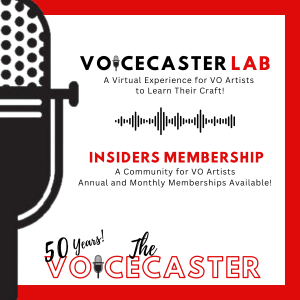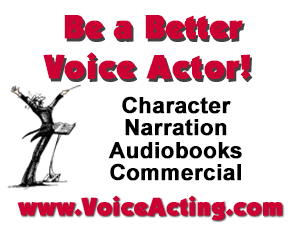|
VOICE ACTING How Audio Will Enhance Or Ruin Your eLearning Projects. Five Tips ... August 30, 2018  In a recent blog, the author advises eLearning developers on the effective use of voice and audio effects in their projects. These tips will help you, too, when serving your eLearning clients ... In a recent blog, the author advises eLearning developers on the effective use of voice and audio effects in their projects. These tips will help you, too, when serving your eLearning clients ...By Dan Hurst Voice Actor The longer I am in this business, the more I learn about the emotion of audio. Think
about it. You have a favorite song, perhaps a favorite band or style of
music. Why? Because it invokes a certain emotion in you. You
love certain sounds of nature. Perhaps ocean waves, or wind through the
pines, or birds singing. Why? Because those sounds connect with you and
focus you on a place you love. The same thing is true with voices.
Certain voices bring comfort, trust, and connection. And while the
opposite is also quite true, this speaks to my point. Using audio in
your eLearning projects can enhance or ruin the effectiveness of your
work. TO IMPROVE YOUR AUDIO ... I'm an audio guy. Voice-overs, to be specific, but audio
nevertheless. And sometimes clients will ask me to help them add music
or sound effects to their projects, which I am happy to do. After doing
this for a several years, and researching what works and doesn't work
(often from my own mistakes), may I make some suggestions on how you can
vastly improve the audio of your eLearning projects, whether you plan
on doing the audio yourself or use another company? 1. Use the audio to connect. Although
there is certainly an emotion that can be invoked by audio, whether it
be with music or voice, the purpose of the audio is not to create an
emotion but to create a connection. Whatever emotion it produces is
entirely up to the participant. Music or voice that attempts to create emotion just sounds dramatic or silly. Connect. Don't emote. 2. The quality of the audio is critical. We
live in a day and age where all of us are bombarded by highly developed
and technically astute audio productions. When we suddenly hear some
audio production that is less than perfect, we notice it right away.
And not only do we notice it, but we form an opinion about it. For
example, I recently called a company from which I ordered
some supplies. The auto attendant voice was fine, but the
announcements and instructions had been recorded too far from the microphone, which
created a hollow, "echoey" effect. Then on top of that, the background
music and the voice were fighting each other for my attention. My
immediate reaction was, "Didn't these people listen back to the very
first thing a customer hears when they call them?" Not a good first
impression. Imagine an entire eLearning project like that! If
you're going to do audio production for your eLearning project, don't
cheapen the project by making it sound cheap. Use some decent equipment.
It doesn't have to be super expensive, but don't shoot yourself in the
foot by taking a let's-do-this-for-as-little-as-we-can attitude. Compare
your audio production with the production of a competitor. Or several.
Which sound best? Why? Let's face it. A USB microphone into a
laptop isn't going to sound as good as a condenser microphone through a
decent interface into your laptop. And even if it does sound good to you
while sitting at your desk, what is it going to sound like to the
end-user? 3. Let it breathe. eLearning is
education. It takes time to absorb the material. A voice-over that is
too fast, or moves from one thought or concept to another too quickly
loses the learner. It's just plain ineffective. If you are doing the
voice-over yourself, quit thinking about reading it, and think about
speaking it. Speak it to someone standing or sitting there in front of
you, or as I prefer to think of it, someone sitting on a park bench with
you. 4. Remember your audience. This
seems pretty simple and superficial, but it is astounding how many
eLearning projects fail to connect the audio with their audience, even
if the teaching content is spot on. Let's face it, if you are targeting
an audience that is primarily urban, it's probably not a good idea to
use a rural sounding voice. No, I know you would never do that. But
would you use a second generation Mexican voice talent from L.A. to voice a
project targeting sugar cane workers in the Dominican Republic? I mean
they both speak Spanish, right? Seriously, one person cannot decide alone which audio sound works for the general audience. It
takes a diversified group with a vested interest in the product to
decide which voice and which music is going to work best for the
project. One person cannot decide for the entire audience. And if you
still aren't sure, make the decision based on some legitimate research! 5. Simple Is Better. Every
layer, every element of your project is something else the end-user has
to absorb and process. And the more things you throw into the mix are
more things that will contribute to learning fatigue. More words, more
color, more sound, more motion all compete for attention and processing. Keep your audio as simple as possible. Don't let it distract. And
speaking of distracting, if you are going to voice your own project,
make sure there are no distracting noises in the background, no
distracting mouth noises, no distracting plosives, no distracting
sibilance, and no distracting speech habits. It occurs to me that
I'm being kind of negative. My apologies. I just want your next project
to shine! And with a little attention to these details, your audio
certainly will. ------------------ ABOUT DAN Dan (Daniel Eduardo) Hurst is an experienced bilingual (English and Spanish) voice talent operating out of the Kansas City area. His business extends internationally, with clients including Maserati, Boehringer Ingelheim, British Petroleum, Kimberly-Clark, McDonald's, Volkswagen, Telemundo International, Shell, Hallmark, TransCanada, and many more, along with his national work for numerous infomercials, ESPN, MLB, and the Golf Channel, among others. When he's not working, he spends time cheering for losing sports teams, getting kicked off of golf courses, and cursing his boat motor. Email: DanHurst@DanHurst.com Web: www.DanHurst.com SEE MORE VALUABLE VOICE ACTING ARTICLES |
As of the NEW website launch, 03/22/2012






.png)



I've never had music requested under full reads in elearning. But occasionally when there is a shift from one section to the next, or if there is a quiz and they want a right or wrong sounder, they'll ask for the sfx. And sometimes if there is a scene where someone...or some people...are talking about something, they might request some background sfx (office noise, restaurant sounds, etc).
But I've been amazed at the number of companies that try to add their own sfx or music, and simply don't know what they're doing. There are usually 2 dead giveaways: Either the music or sfx is too loud or soft, or they have no idea how to fade the music so they just cut it off. I kinda feel bad for them.
Larry